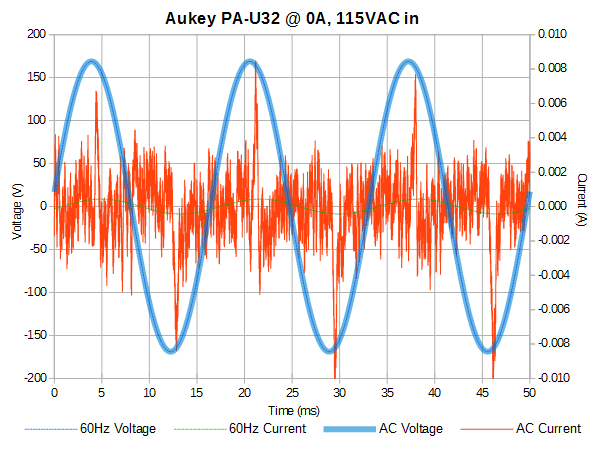Aukey PA-U32 USB Power Adapter Tear-Down
Standby Power
With an integral power of 34mW at 115V and 71mW at 240V, Aukey’s adapter is well within Level-VI’s 100mW limit. If we were looking at apparent power, including harmonics, though, the noise would bump input power to 253mVA at 115V. Be thankful that most countries don’t bill residential consumers for reactive power, harmonics, and noise. At least not yet.
MORE: AmazonBasics ABHT1208TC Tear-Down
MORE: CyberPower EC350G Tear-Down
MORE: How (And Why) We Test USB Power Adapters
Efficiency
While the PA-U32 uses a less efficient Schottky diode for rectification, trailing ~5% behind SilverStone’s UC01 that uses synchronous rectification, it still stays well ahead of Level-VI’s requirement throughout its output range.
On 115V input, Aukey’s adapter outputs 2.45A before its current limit kicks in. It hits 2.35A at 230V, landing 50mA short of its nominal output. Such a small discrepancy can be overlooked considering that primary-side feedback designs have no direct output monitoring.
MORE: AmazonBasics ABHT1208TC Tear-Down
Get Tom's Hardware's best news and in-depth reviews, straight to your inbox.
MORE: CyberPower EC350G Tear-Down
MORE: How (And Why) We Test USB Power Adapters
Output Voltage Regulation
Output voltage holds steady from no load until 1.5A on 115V and 2A on 230V input, then it dips by roughly 100mV per additional 500mA. We find no problem here.
MORE: AmazonBasics ABHT1208TC Tear-Down
MORE: CyberPower EC350G Tear-Down
MORE: How (And Why) We Test USB Power Adapters
Output Noise Waveform
For an adapter lacking a Y-class capacitor, this is a surprisingly clean ripple waveform with no obvious switching transients. There has to be some, though; my oscilloscope says there is 124mVPP of noise in there, despite only ~60mV being clearly visible. Perhaps a shield winding between the secondary and other windings is mitigating leakage.
At 24 cycles spanning 12 divisions of 50µs each, the adapter operates at a surprisingly low switching frequency of 40 kHz. Simply increasing the frequency to 60 kHz, which is more common for monolithic off-line switching regulator ICs, would significantly reduce ripples.
MORE: AmazonBasics ABHT1208TC Tear-Down
MORE: CyberPower EC350G Tear-Down
MORE: How (And Why) We Test USB Power Adapters
Output Noise
Noise plots make the story more interesting. At 115V input, peak-to-peak noise remains nearly constant in the low 80mV range all the way through 2.4A, while it gets progressively worse on 230V starting from 1.5A.
On the RMS side of things, the adapter remains below 20mV in all cases other than hitting its limit, which is well within BC 1.2’s specs of anything from 4.45V through 5.25V measured at the end of a cable under load being fair game.
MORE: AmazonBasics ABHT1208TC Tear-Down
MORE: CyberPower EC350G Tear-Down
MORE: How (And Why) We Test USB Power Adapters
Transient Response
Upon applying an extra load, output voltage very briefly dips by 150mV and bounces back to being within 50mV in less than 5ms. When the extra load gets removed, the output overshoots to 150mV for 2-3ms, spends more than 5ms at 100mV above, and needs about 15ms to settle back down within 50mV. Both results land within BC 1.2’s 4.1V maximum undershoot (900mV dip) and 6V maximum overshoot (1V bump) limits.
Is laggy load dump response going to be a hallmark of primary-side sensing designs? We’ll see as I run into more of these in the future.
MORE: AmazonBasics ABHT1208TC Tear-Down
MORE: CyberPower EC350G Tear-Down
MORE: How (And Why) We Test USB Power Adapters
Short-Circuit Response
Under a short-circuit condition, the output current oscillates between ~2.2A and 3.4A for 15-30ms before the converter shuts down for 600-700ms, generating faintly audible chirps as it cycles on and off.
MORE: AmazonBasics ABHT1208TC Tear-Down
MORE: CyberPower EC350G Tear-Down
MORE: How (And Why) We Test USB Power Adapters
Isolation Withstand Test
Does Aukey’s PA-U32 survive my 3.5kVAC isolation withstand test? Yes, it does, and with considerably less hissing than my SilverStone UC01, although that could simply be due to me running the test on top of a cardboard box specifically to reduce electric field gradients caused by proximity to my grounded anti-static mat, which would promote ionization.
MORE: AmazonBasics ABHT1208TC Tear-Down
MORE: CyberPower EC350G Tear-Down
MORE: How (And Why) We Test USB Power Adapters
First Serious Recommendation?
Aukey’s PA-U32 landed 50mA shy of delivering its nominal 2.4A output current at 230V. It delivers cleaner power than what BC 1.2 requires, features an internal design that leaves very little to chance regarding safety, has a functional over-current limit that shouldn’t melt your cables or burn internal components, and it passed my 3500VAC insulation withstand test.
While the Asia’x capacitors may raise concerns about useful life, the only notable concern I have safety-wise is that solder splash on the diode, which came off as I removed the board from its frame. A loose solder flake isn’t something you want rattling around SMDs at 160-400VDC between pads.
Assuming this was merely bad manufacturing luck (it's impossible to tell from a single sample), the PA-U32 may very well make it onto my recommendable list.
MORE: AmazonBasics ABHT1208TC Tear-Down
MORE: CyberPower EC350G Tear-Down
MORE: How (And Why) We Test USB Power Adapters









